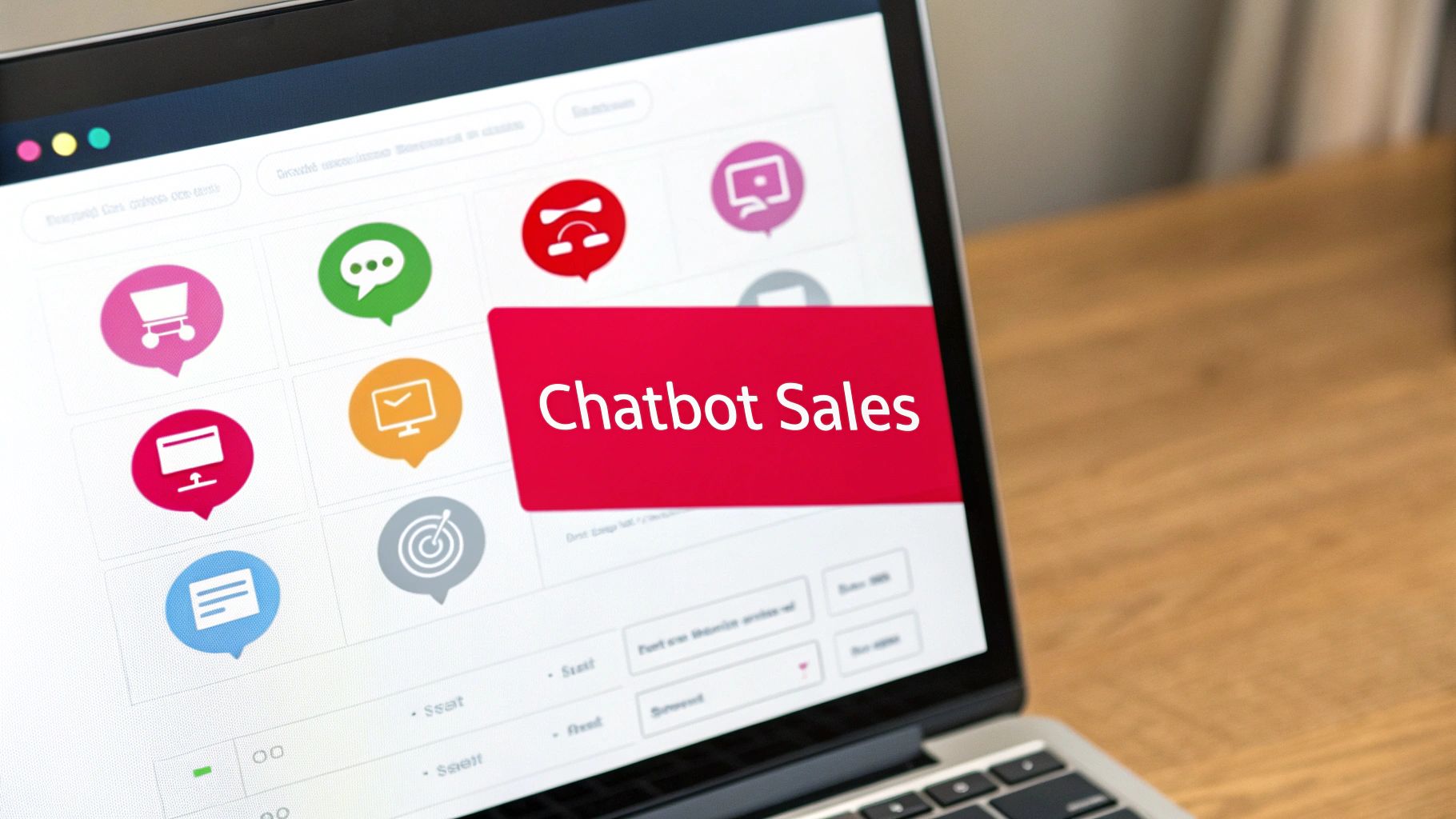 10 Social Commerce Trends Dominating 2025
10 Social Commerce Trends Dominating 2025
In 2025, social media has evolved far beyond a simple channel for brand awareness; it's a powerful, direct-to-consumer sales engine. However, simply posting product photos is no longer enough. To truly capitalize on platforms like TikTok, Instagram, and Facebook, businesses need sophisticated social media sales strategies that engage customers, build trust, and seamlessly guide them from discovery to checkout.
The modern consumer expects authentic interactions, personalized experiences, and frictionless purchasing. This article dives into 10 actionable strategies that harness the power of creator collaborations, user-generated content (UGC), social commerce, and data-driven targeting to transform your social presence into a predictable revenue stream.
Whether you're an e-commerce brand or a B2B service provider, these proven tactics will equip you to not only meet but exceed your sales goals in today's competitive digital marketplace. We'll explore how to move beyond vanity metrics and focus on what truly matters: driving measurable growth. You will learn specific, practical methods to integrate sales directly into your social media efforts, from leveraging influencer partnerships and live stream selling to implementing advanced retargeting and automated chatbot funnels. Let's get started.
Table of Contents
1. Influencer Partnership Sales
Influencer partnership sales are a cornerstone of modern social media sales strategies, leveraging the trust and authority that creators have with their dedicated followers. This approach moves beyond simple brand awareness, focusing on driving direct conversions by having influential personalities authentically integrate your products into their content. It capitalizes on social proof, as a recommendation from a trusted influencer often feels more like a suggestion from a friend than a traditional advertisement.

Brands like Gymshark and Fashion Nova perfected this model by building long-term relationships with fitness and fashion influencers, making their apparel seem like an essential part of a desirable lifestyle. The key is finding creators whose audience perfectly matches your target demographic.
How to Implement Influencer Sales
To effectively launch these initiatives and maximize your return, understanding the mechanics of how to collaborate with influencers is crucial. Start by defining clear campaign goals, such as a specific number of sales or a target return on ad spend (ROAS).
- Prioritize Engagement: Look beyond follower counts. A micro-influencer with a highly engaged, niche audience can often drive more sales than a macro-influencer with passive followers.
- Arm with Tools: Provide unique, trackable discount codes or affiliate links for each influencer. This not only incentivizes their audience to purchase but also allows you to accurately measure the ROI of each partnership.
- Grant Creative Freedom: While providing brand guidelines is important, allow influencers the creative flexibility to present your product in their own voice. This ensures the endorsement feels genuine and resonates with their audience.
2. Social Commerce Integration
Social commerce integration transforms social media platforms from discovery channels into complete point-of-sale systems. This strategy embeds shopping functionality directly into the user experience, allowing customers to browse, select, and purchase products without ever leaving the app. By removing friction from the buying journey, it effectively shortens the sales funnel and capitalizes on the impulse-driven nature of social media scrolling, making it one of the most direct social media sales strategies.

Platforms like Instagram and Facebook have pioneered this with features like product tags and dedicated Shop tabs, turning a brand’s profile into a fully functional digital storefront. This seamless process captures consumer interest at its peak, converting passive browsers into active buyers in just a few taps.
How to Implement Social Commerce
Effectively implementing social commerce requires more than just enabling the feature; it involves curating a native shopping experience. You must synchronize your product catalog with platforms like Facebook Shops or set up shoppable pins on Pinterest, ensuring your inventory is always up to date.
- Optimize Product Visuals: Each platform has unique visual standards. Use high-resolution, mobile-first images and videos that showcase your products in an authentic, lifestyle-oriented context.
- Write Compelling Copy: Craft concise, benefit-driven product descriptions that are optimized for small screens. Clearly state the price and use a strong call-to-action to encourage immediate purchase.
- Leverage User-Generated Content (UGC): Tag products in authentic photos and videos shared by your customers. This adds a layer of social proof directly at the point of purchase, significantly boosting conversion rates.
- Stay Updated on Features: Social platforms constantly release new commerce tools. Actively monitor these updates and be among the first to adopt new features like live shopping events or AR try-on functionalities to gain a competitive edge.
3. Social Listening and Lead Generation
Social listening for lead generation is a proactive sales strategy that transforms passive monitoring into an active opportunity pipeline. Instead of waiting for customers to find you, this approach involves tracking conversations across social platforms to identify users expressing purchase intent, pain points your product solves, or dissatisfaction with a competitor. It’s about joining the right conversation at the right moment to offer a solution.

Companies like HubSpot excel at this by monitoring discussions around "CRM frustrations" or "sales software challenges," allowing their teams to engage with timely, helpful advice. This method positions your brand as a problem-solver first and a vendor second, building trust from the initial interaction.
How to Implement Social Listening for Sales
To effectively turn conversations into conversions, you need a systematic process. To dive deeper into converting followers into leads, consider exploring effective social media lead generation strategies that complement this approach. Begin by setting up alerts and streams in a social listening tool like Hootsuite or Sprout Social.
- Set Up Keyword Alerts: Track brand mentions, but also go broader. Monitor industry-specific keywords, pain points (e.g., "email marketing is hard"), and competitor names combined with negative sentiment words ("frustrated with," "alternative to").
- Monitor Competitor Mentions: Keep a close watch on your competitors' social channels and tagged posts. When a customer expresses frustration or asks for alternatives, it creates a prime opportunity for you to offer a solution.
- Engage Authentically, Don't Pitch: The first interaction should never be a hard sell. Offer genuine advice, answer a question, or share a helpful resource. Focus on building rapport before guiding them toward a sales-oriented conversation.
- Train Your Team: Equip your sales and social media teams with clear guidelines on engagement etiquette. Define the brand's voice, response protocols, and the appropriate time to transition from a public chat to a private message or demo request.
4. Live Stream Selling
Live stream selling transforms the digital shopping experience into an interactive, real-time event. This social media sales strategy combines live video with immediate purchasing capabilities, allowing brands to demonstrate products, answer questions, and drive sales in a dynamic, engaging format. It effectively digitizes the in-person retail experience, building community and creating a sense of urgency that encourages on-the-spot conversions.

Pioneered by platforms like QVC and now mastered on channels such as TikTok Shop and Amazon Live, this method thrives on direct customer interaction. Brands like Sephora host live makeup tutorials where viewers can instantly purchase featured products, merging education with e-commerce seamlessly.
How to Implement Live Stream Selling
To execute a successful live selling event, you must blend entertainment with a clear path to purchase. The goal is to create an unmissable experience that feels both authentic and exclusive.
- Promote Extensively: Build anticipation by promoting your live session across all marketing channels, including email, social media stories, and posts. Announce special, live-only offers to maximize attendance.
- Engage in Real-Time: Actively monitor and respond to comments and questions as they come in. Addressing viewers by name and featuring their questions makes the experience personal and interactive.
- Offer Exclusive Value: Provide a compelling reason to tune in and buy now. This could be a limited-time discount, a gift with purchase, or first access to a new product, all exclusively available to your live audience.
5. User-Generated Content Campaigns
User-generated content (UGC) campaigns transform your customers into your most authentic marketers. This strategy involves encouraging your audience to create and share content featuring your products, which acts as powerful social proof for their networks and beyond. By turning customer advocacy into a key part of your social media sales strategies, you build trust and generate organic marketing that directly influences purchasing decisions. It’s a peer-to-peer recommendation at scale, showcasing genuine product use.
GoPro built its brand on the back of thrilling customer-shot adventure videos, while Starbucks’ annual #RedCupContest generates massive engagement and reinforces its holiday brand identity. These campaigns succeed by making the customer the hero of the brand’s story, fostering a community that actively participates in its marketing.
How to Implement User-Generated Content Campaigns
To launch a successful UGC initiative that drives sales, you need a structured framework that encourages participation and leverages the content effectively. This means creating a clear value exchange where customers are excited to contribute.
- Create Clear Guidelines and Hashtags: Establish a unique, branded hashtag for your campaign (like Coca-Cola’s #ShareACoke). Provide simple instructions on what kind of content you’re looking for to ensure brand alignment and make it easy for users to participate.
- Offer Meaningful Incentives: Motivate participation by offering compelling rewards. This could be anything from a chance to win a prize, a significant discount on a future purchase, or the opportunity to be featured prominently on your brand’s official social media channels.
- Feature and Engage with Submissions: Actively showcase the best UGC on your profiles, website, and even in your email marketing. Always credit the original creator and engage with their posts to show appreciation and encourage more submissions. This reinforces the community aspect and validates participants' efforts.
6. Social media Retargeting
Social media retargeting is a sophisticated strategy that reconnects your brand with users who have already shown interest in your products or services. By using tracking pixels and customer data, it allows you to display highly relevant ads to people who have visited your website, abandoned a cart, or engaged with your social media content. This approach is powerful because it targets a warm audience, keeping your brand top-of-mind and guiding prospects back into the sales funnel for conversion.
Retail giants like Amazon have mastered this, showing you ads for the exact products you viewed after you leave their site. Similarly, Booking.com retargets users with ads for the specific hotels they searched for, creating a compelling reason to complete the booking. It's one of the most effective social media sales strategies for recapturing lost leads.
How to Implement Social Media Retargeting
To execute this strategy, you must first install tracking pixels, like the Meta Pixel or TikTok Pixel, on your website. This is the foundation for building custom audiences based on user behavior.
- Segment Your Audience: Don’t show the same ad to everyone. Create specific audience segments based on behavior, such as "viewed product but didn't add to cart," "added to cart but abandoned," or "visited specific blog posts."
- Craft Compelling Ad Creative: Tailor your ads to address why the user might have left. For cart abandoners, an ad featuring a limited-time discount or a testimonial for that specific product can be highly effective.
- Set Frequency Caps: Avoid ad fatigue by limiting how often a single user sees your retargeting ads within a specific period. Bombarding users can lead to negative brand perception and ad blindness.
- Test and Optimize: Continuously test different ad formats, messaging sequences, and timing. An ad shown three days after a site visit might perform better than one shown after just one day.
7. Community Building and Engagement
Community building is a long-term social media sales strategy that focuses on nurturing a dedicated space for customers and fans to connect. Instead of broadcasting marketing messages, this approach generates sales by fostering loyalty, trust, and peer-to-peer recommendations. It transforms one-time buyers into brand advocates who feel a genuine sense of belonging. This strategy creates a powerful feedback loop where authentic engagement drives both retention and new customer acquisition.
Peloton's dedicated rider groups and Sephora's Beauty Insider community are prime examples of this model in action. These brands created ecosystems where members share tips, celebrate successes, and seek advice, making the brand an integral part of their lifestyle. The sales that result feel organic because they are driven by genuine user passion rather than a direct sales pitch.
How to Implement Community Building
To build a community that drives revenue, the focus must shift from selling to serving. When members feel valued, their loyalty translates directly into sales. A deeper understanding of your community's growth can be gained when you learn how social media reach is calculated, as this metric informs engagement potential.
- Prioritize Value-Driven Content: Focus on providing value before asking for a sale. Share exclusive content, host expert Q&As, or offer early access to new products to make members feel like insiders.
- Encourage Peer-to-Peer Interaction: Actively facilitate conversations between members. Pose questions, create discussion threads, and celebrate user-generated content to foster a self-sustaining environment where the community supports itself.
- Listen and Actively Participate: Be a present member of your own community. Respond to comments, ask for feedback, and show that you are listening. Use insights gathered from discussions to inform product development and marketing decisions.
8. Social Proof and Testimonial Marketing
Social proof and testimonial marketing is a powerful social media sales strategy that builds trust by showcasing positive experiences from existing customers. This approach leverages the psychological principle that people are more likely to take an action if they see others doing it. By prominently featuring customer reviews, user-generated content, case studies, and endorsements, you provide the validation needed to convert hesitant prospects into confident buyers. It’s about letting your happy customers become your most effective salespeople.
This strategy was foundational to the growth of platforms like Amazon and TripAdvisor, which built entire ecosystems around user reviews. In the B2B space, companies like Slack and Shopify use customer success stories and detailed case studies to demonstrate their value to enterprise clients, making abstract benefits feel tangible and proven.
How to Implement Social Proof Marketing
To effectively integrate testimonials into your social media sales strategies, you must systematize the collection and promotion of customer feedback. The goal is to make social proof a constant and visible part of your brand's online presence.
- Systematize Review Collection: Automate requests for reviews as part of your post-purchase customer journey. Use email or SMS follow-ups to ask for feedback and make the process as simple as possible.
- Prioritize Video Testimonials: A video of a customer sharing their positive experience has a significantly higher impact than text alone. It feels more authentic and creates a stronger emotional connection with potential buyers.
- Feature Diverse Stories: Showcase a wide range of customer stories and use cases. This helps different segments of your audience see themselves in your existing customers, making your solution feel more relevant to their specific needs.
- Integrate Everywhere: Don't just post testimonials on a dedicated page. Weave them into your product announcements, ad creatives, social media bios, and even your checkout process to reinforce trust at every touchpoint.
9. Chatbot and Automated Sales Funnels
Chatbot and automated sales funnels represent a powerful evolution in social media sales strategies, using AI to provide immediate, scalable engagement. This approach deploys intelligent chatbots directly within platforms like Facebook Messenger and Instagram DMs to qualify leads, answer common questions, and guide users toward a purchase. It effectively creates a 24/7 sales assistant that can handle countless conversations at once, ensuring no potential customer is left waiting.
This strategy transforms passive social media interaction into an active sales channel. Instead of waiting for a user to click a link and leave the app, the entire initial sales process can occur within the messaging interface they are already using.
How to Implement Chatbot Sales Funnels
Companies like ManyChat and Chatfuel have made building these automated funnels highly accessible. The key is to design conversational flows that feel helpful, not robotic. Success with these social media sales strategies hinges on providing value first.
- Design Natural Conversation Flows: Map out the customer journey and script conversations that anticipate user questions and needs. Start with a friendly greeting and offer clear options, like "Learn more," "See products," or "Talk to a human."
- Provide an Escape Hatch: Always include an easy and obvious way for users to escalate to a human representative. A frustrating bot experience can lose a sale, so a seamless handover to your support or sales team is critical.
- Use Bots for Qualification, Not Closing: Deploy chatbots to handle initial lead qualification, segment audiences, and answer frequently asked questions. Reserve complex negotiations and final closing for human agents who can add a personal touch.
- Test and Optimize Relentlessly: Continuously monitor your bot’s performance. Analyze drop-off points, test different conversation starters, and refine responses based on user interactions to improve conversion rates over time.
10. Content Marketing with Sales Integration
Content marketing with sales integration is a sophisticated social media sales strategy that prioritizes building trust and authority through valuable information. Instead of direct promotion, this method involves creating educational content that solves your audience's problems, with sales messaging woven in subtly alongside clear conversion pathways. This approach nurtures prospects through the buyer's journey, using content as the primary vehicle to demonstrate product value and guide them toward a purchase decision.
Brands like HubSpot have mastered this by offering comprehensive marketing education, which naturally leads users to its software solutions. Similarly, Buffer provides extensive social media strategy resources, positioning its scheduling tool as the logical next step for implementation. The goal is to become an indispensable resource first, making the sale a natural consequence of the trust you've built.
How to Implement Content Marketing with Sales Integration
To turn your educational content into a consistent sales channel, you must strategically connect information to action. To maintain a consistent presence and efficiently engage your audience, understanding how to automate content creation for social media is crucial for modern sales strategies.
- Solve, Don't Sell: Center your content around customer pain points and questions. Use data and analytics to identify popular topics, and collaborate with your sales team to understand common objections that content can proactively address.
- Provide Clear Next Steps: Each piece of content, whether a blog post, video, or infographic, should have a clear and relevant call-to-action (CTA). This could be downloading a more detailed guide, signing up for a webinar, or booking a demo.
- Repurpose Strategically: Adapt your core content pieces for different social platforms. A detailed guide can be broken down into a Twitter thread, an Instagram carousel, a series of TikTok videos, and a LinkedIn article to maximize reach and engagement across your channels.
Social Media Sales Strategies Comparison
| Strategy | Implementation Complexity 🔄 | Resource Requirements ⚡ | Expected Outcomes 📊 | Ideal Use Cases 💡 | Key Advantages ⭐ |
|---|---|---|---|---|---|
| Influencer Partnership Sales | Medium – requires managing multiple influencers and campaigns | Medium – influencer fees and coordination effort | High engagement and targeted reach | Brands targeting specific demographics via social influencers | Builds brand credibility through trusted endorsements |
| Social Commerce Integration | High – technical integration with platforms and updates | High – platform fees, setup and maintenance | Increased conversion rates and seamless shopping experience | Retailers aiming to reduce purchase friction and capitalize on impulse buys | Smooth, in-app checkout enhances buying ease |
| Social Listening & Lead Generation | Medium-High – requires tools and ongoing monitoring | Medium – software licenses and analyst time | Early identification of prospects and competitive intelligence | B2B and B2C sales teams monitoring social intent and sentiment | Data-driven approach with real-time engagement |
| Live Stream Selling | High – requires production setup and live hosting expertise | High – equipment, manpower, and preparation | High engagement and urgency-driven immediate sales | Brands with visual products aiming for interactive selling experiences | Creates personal connection and instant feedback |
| User-Generated Content Campaigns | Medium – content curation and campaign management | Low-Medium – incentivizing participants | Authentic social proof and organic network reach | Brands leveraging customer advocacy to boost credibility | Cost-effective with high engagement |
| Social Media Retargeting | High – requires pixel implementation and campaign management | Medium – ad spend and technical setup | Increased conversions from warm leads | E-commerce and service providers targeting interested visitors | Personalized, cost-effective targeting |
| Community Building & Engagement | High – ongoing management and content creation | Medium-High – community managers and content resources | Long-term loyalty and word-of-mouth sales | Brands seeking long-term customer retention and feedback | Builds deep brand loyalty and organic marketing |
| Social Proof & Testimonial Marketing | Medium – content collection and integration | Low-Medium – content gathering and curation | Trust building and reduced purchase hesitation | Businesses emphasizing credibility and social validation | Significantly increases conversion rates |
| Chatbot & Automated Sales Funnels | Medium-High – chatbot design and platform integration | Medium – AI tools and ongoing optimization | 24/7 lead qualification and scalable customer engagement | Brands needing scalable initial lead handling and quick responses | Instant, consistent engagement with reduced labor |
| Content Marketing with Sales Integration | High – continuous content creation and strategy alignment | High – content production and analytics | Authority building and qualified lead attraction | Companies focusing on educating prospects through inbound marketing | Supports full buyer journey and long-term growth |
Integrating Your Strategies for Maximum Sales Impact
Navigating the landscape of social media sales can feel like managing a complex orchestra. Each strategy we've explored, from Influencer Partnership Sales to Chatbot-driven Funnels, represents a powerful instrument capable of producing results on its own. A well-executed User-Generated Content campaign can build trust, while a sharp retargeting ad can recover abandoned carts. However, true commercial harmony is achieved not by playing these instruments in isolation, but by conducting them in a cohesive symphony. The most effective social media sales strategies are integrated, creating a seamless customer journey that feels both organic and compelling.
Imagine the amplification effect: you identify a high-intent lead through Social Listening, then use Social Media Retargeting to show them authentic User-Generated Content from a recent campaign. That same UGC is then featured on your product pages, enhanced with Social Commerce tags, allowing new visitors to buy directly from a real customer's photo. This multi-layered approach transforms disparate tactics into a powerful, self-reinforcing sales engine.
Building Your Integrated Sales Ecosystem
To move from theory to implementation, focus on creating connections between your chosen strategies. The goal is to build an ecosystem where each component supports and enhances the others.
- Connect Content to Commerce: Don't let great content exist in a vacuum. Whether it's a powerful testimonial, a live stream demonstration, or a stunning influencer photo, ensure every piece of content has a clear path to purchase through integrated shopping tags, clear calls to action, or direct links in your bio.
- Leverage Data Across Channels: Insights gained from Social Listening should inform your ad targeting. Engagement data from your Community Building efforts should highlight your most valuable brand advocates, who can then be invited into a UGC or testimonial campaign.
- Automate for Efficiency: Use Chatbots and Automated Sales Funnels not just to answer FAQs, but to guide users who engage with your ads or influencer content, providing personalized recommendations and moving them closer to a decision.
The Path Forward: Test, Measure, and Refine
Mastering this integrated approach is not a one-time setup; it is an ongoing process of refinement. The digital marketplace is in constant flux, with new platform features and shifting consumer behaviors. Your commitment to testing different combinations, meticulously measuring performance, and iterating on what works will be the ultimate key to sustained revenue growth. Start by identifying two or three strategies that align most closely with your brand and audience. Implement them, establish your key performance indicators, and track your results. As you gain confidence and gather data, you can begin weaving in additional tactics to create an even more robust and profitable framework. By adopting this mindset, you transform your social media from a simple marketing channel into a dynamic and predictable sales machine, future-proofing your brand's success in an ever-evolving digital world.
Ready to streamline your content creation and supercharge your UGC campaigns? JoinBrands provides an all-in-one platform to discover creators, manage collaborations, and source high-quality, authentic content at scale. Stop searching and start creating by exploring the powerful tools at JoinBrands today.








